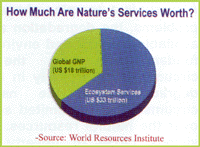|
BENEVOLENT
BIODIVERSTY
Biodiversity encompasses a
variety of plants and animals, microorganisms as well as the
eco-systems and ecological processes to which they belong.
 Biodiversity
is part of our lives and livelihood and comprises the resources
upon which families, communities, nations and the future generations
depend. Biodiversity
is part of our lives and livelihood and comprises the resources
upon which families, communities, nations and the future generations
depend.
Biodiversity with vast array of essential services, especially
the tangible economic benefits in terms of edible, medicinal
and commercial raw material provides a natural foundation
for food, heath and livelihood security of human being .The
role and importance of biodiversity in maintaining the life
support system is better understood now and for its in-situ
conservation, Protected Areas (PAs) have been established
across the globe.
International Convention of Biodiversity (CBD) , to which
India is a signatory, recognizes that the most effective and
practical way of preserving biological diversity and ecological
processes that modulate various other life processes, is the
establishment of Protected Areas Network (PAN)
In India, the PA network has been largely targeted on faunal
aspects, envisaging exclusion of anthropogenic pressure from
the forests. However, poor people may not conserve biodiversity
if the process of conservation competes with their survival
needs.
The ground reality is that the ecological security of the
protected Areas (PAs), divorced from livelihood security of
the people, has no future.The organic link between the conservation
and sustainable utilization by the dependent people will require
a resilient and adaptive management which can reconcile the
dichotomy of threat perceptions arising out of conservation-develoment
orthodoxy by taking into account the human sensitivities in
terms of the felt needs of the people, their social norms,
beliefs and systems borne out of history, culture and traditions.
To conjugate the above premise with developmental process,
the concept of People's Protected Area
which may also be termed as the Poor
People's Pool Of Assets , has emerged, which aims at facilitating
poor people's access to physical, material, human,
social and environmental assets.
The people's Protected Areas are in consonance with the IUCN
category VI which delineate sites containing predominantly
unmodified natural systems, under management to ensure the
long term protection and maintenance
of biological diversity, whilst providing at the same
time a sustainable flow of natural products
and services to meet local community needs.
Diagrammatically, capital base of PPAs is depicted below :
| MADHYAPRADESH
STATE BIODIVERSITY - at a glance |
- India is one off the twelve mega-diversity countries
of the world.
- Madhya pradesh with 9.38% geographical area of the
country accounts for 12.44% of the country's forests.
- 31% of the geographical area of the state amounting
to 9.5 million hectares is under forests.
- A state Biodiversity Board has been constituted
under the chairmanship of Hon'ble chief Minister ,
Madhya Pradesh President with Dr. M.S. Swaminathan
as advisor.
- The Dry and Moist Deciduous Tropical Forests which
are abundant in the state,are estremely rich in terms
Of both floral and faunal biodiversity.
- MP has got approximately 800 Tigers which account for 19%
tiger population of the world.
- The Faunal Biodiversity in the country is managed
as per provisions of the wild Life Protection Act,1972[as
Amended in 1990]. This however, does not provide for
sharing of the faunal resources with the user groups.
- Floral biodiversity has largely become an Open Access
Resource [QAR] resulting in degradation and extinction
of some of the Highly valuable an important species
of ecological and economic significance.The state
has initiated to convert these Open Access Resources
into Community Controlled Natural Resources.
- Nonetheless wide variety of medicinal plants and
other economically important NWFP is still available
in the state.
- The state has involved more than 2000 village level
committees and 1066 primary cooperative Societies
for managing the forests and forest resources.
- The state is now taking initiatives towards conserving
propagating and
|
Biodiversity is the foundation
for progress in strengthening food, health and livelihood
security. Biodiversity is also the feedback for modern bio-technology.
industry. Effectively used, it can become a major instrument for
economic prosperity of the state as well as communities.
Madhya Pradesh Biodiversity
Board |
|


 Biodiversity
is part of our lives and livelihood and comprises the resources
upon which families, communities, nations and the future generations
depend.
Biodiversity
is part of our lives and livelihood and comprises the resources
upon which families, communities, nations and the future generations
depend. 


















